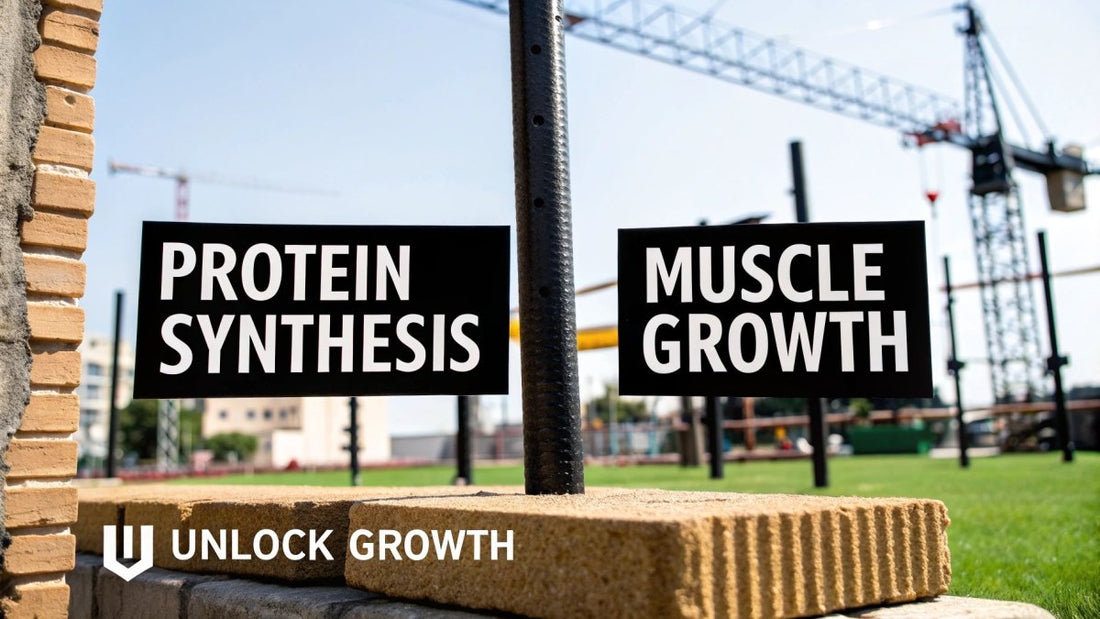
What is Muscle Protein Synthesis? Unlock Your Muscle Growth
Share
If you've ever lifted weights, you've probably heard the term Muscle Protein Synthesis, or MPS. But what is it, really? Think of it as your body's own internal construction crew, tirelessly working to repair and build muscle tissue. It's the engine that drives all your gains.
Whenever you hit the gym for a tough session, you’re creating tiny, microscopic tears in your muscle fibers. This sounds bad, but it’s actually the spark that ignites the whole muscle-building process. This damage sends a signal to your body to kickstart MPS.
The Blueprint for Building Stronger Muscles
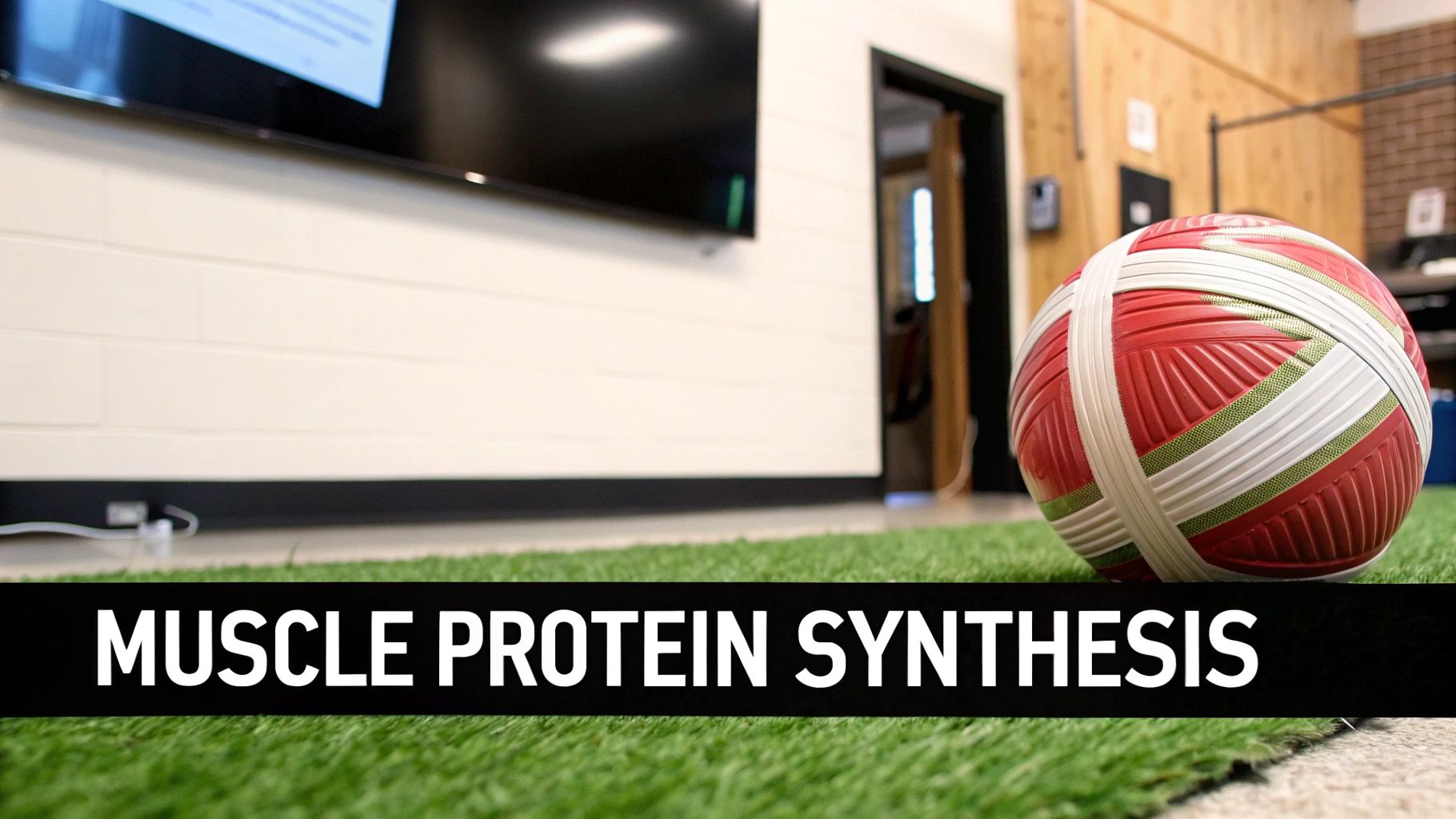
Let’s use a simple analogy: imagine your muscles are a brick wall. A hard workout is like a sledgehammer creating small cracks and holes in that wall. In response, your body dispatches the MPS construction crew. They don't just patch the holes—they add new bricks, making the wall thicker, stronger, and more resilient for the next time. That's muscle growth in a nutshell.
This whole cycle of breaking down and rebuilding is happening constantly. Your overall muscle mass depends on the balance between two key processes:
- Muscle Protein Synthesis (MPS): The building-up process.
- Muscle Protein Breakdown (MPB): The tearing-down process.
When MPS happens faster than MPB, you're in what's called an anabolic state. This is the sweet spot for muscle growth (hypertrophy). On the flip side, if breakdown outpaces synthesis, you enter a catabolic state and start losing muscle. If they're perfectly balanced, you just maintain what you have.
To give you a clearer picture, here’s a quick breakdown of these core ideas.
Muscle Protein Synthesis At A Glance
| Concept | Simple Explanation |
|---|---|
| Muscle Protein Synthesis (MPS) | Your body's process of using protein to repair and build new muscle fibers. |
| Muscle Protein Breakdown (MPB) | The natural process of breaking down old or damaged muscle proteins for removal. |
| Anabolic State (Growth) | Occurs when Muscle Protein Synthesis > Muscle Protein Breakdown. You gain muscle. |
| Catabolic State (Loss) | Occurs when Muscle Protein Breakdown > Muscle Protein Synthesis. You lose muscle. |
| Stimulus | The trigger for MPS, primarily resistance training and protein consumption. |
Ultimately, understanding these concepts is the first step toward taking control of your results.
The Daily Cycle of Repair and Growth
Your muscles are always in a state of flux. Every single day, your body turns over about 1–2% of its total skeletal muscle. This means a small portion is constantly being broken down and rebuilt, even on your rest days. But what really tips the scales is the right kind of stimulus.
Exercise, particularly resistance training, is the most powerful MPS trigger. Research shows just how big of a difference it makes. In muscles that have been worked out, the synthesis rate can jump to around 1.984% per day. Compare that to just 1.642% per day in muscles that were rested. If you want to dig into the science, you can explore the full study on muscle turnover rates for a deeper dive.
At its core, knowing what muscle protein synthesis is gives you the power to dictate your own fitness outcomes. By smartly using training and nutrition to stimulate MPS, you are giving your body direct instructions to build the stronger physique you're working for.
Your goal is simple: spend as much time as possible in that anabolic, muscle-building state. Everything you do—from how hard you train to what and when you eat—plays a part in managing this crucial balance. It's how you turn all that sweat and effort into real, visible gains. This guide will show you exactly how to do it.
How Your Body Activates Muscle Growth
To kick off muscle growth, your body needs a very specific signal. Think of it like a construction site—nothing happens until the foreman gives the go-ahead. In this case, the most powerful signal you can send is the mechanical tension from resistance training. Lifting weights essentially tells your muscle cells, "Hey, we need to get stronger to handle this load next time."
That stress from your workout is the trigger, setting off a chain reaction inside your cells. It flips the switch on a crucial signaling pathway known as mTOR (mammalian target of rapamycin). You can picture mTOR as the master foreman of your muscle-building project. Once it gets the signal, its job is to rally the troops and manage all the resources needed to repair and build new muscle tissue.
The mTOR Pathway: The Master Coordinator
When you lift, that tension on your muscle fibers turns mTOR "on." Once active, mTOR takes charge of the entire muscle-building operation from start to finish. It's the central coordinator making sure everything is in place for effective repair and growth.
This process requires a few key players to get the job done:
- Amino Acids: These are the bricks and mortar—the raw materials for building new muscle. You get them from the protein you eat.
- Ribosomes: These are the construction workers. They're tiny cellular machines that take the amino acids and assemble them into new proteins.
- mRNA (Messenger RNA): This is the architect's blueprint, copied directly from your DNA. It carries the specific instructions telling the ribosomes which amino acids to grab and in what order.
This infographic gives you a simple visual of how these pieces fit together.
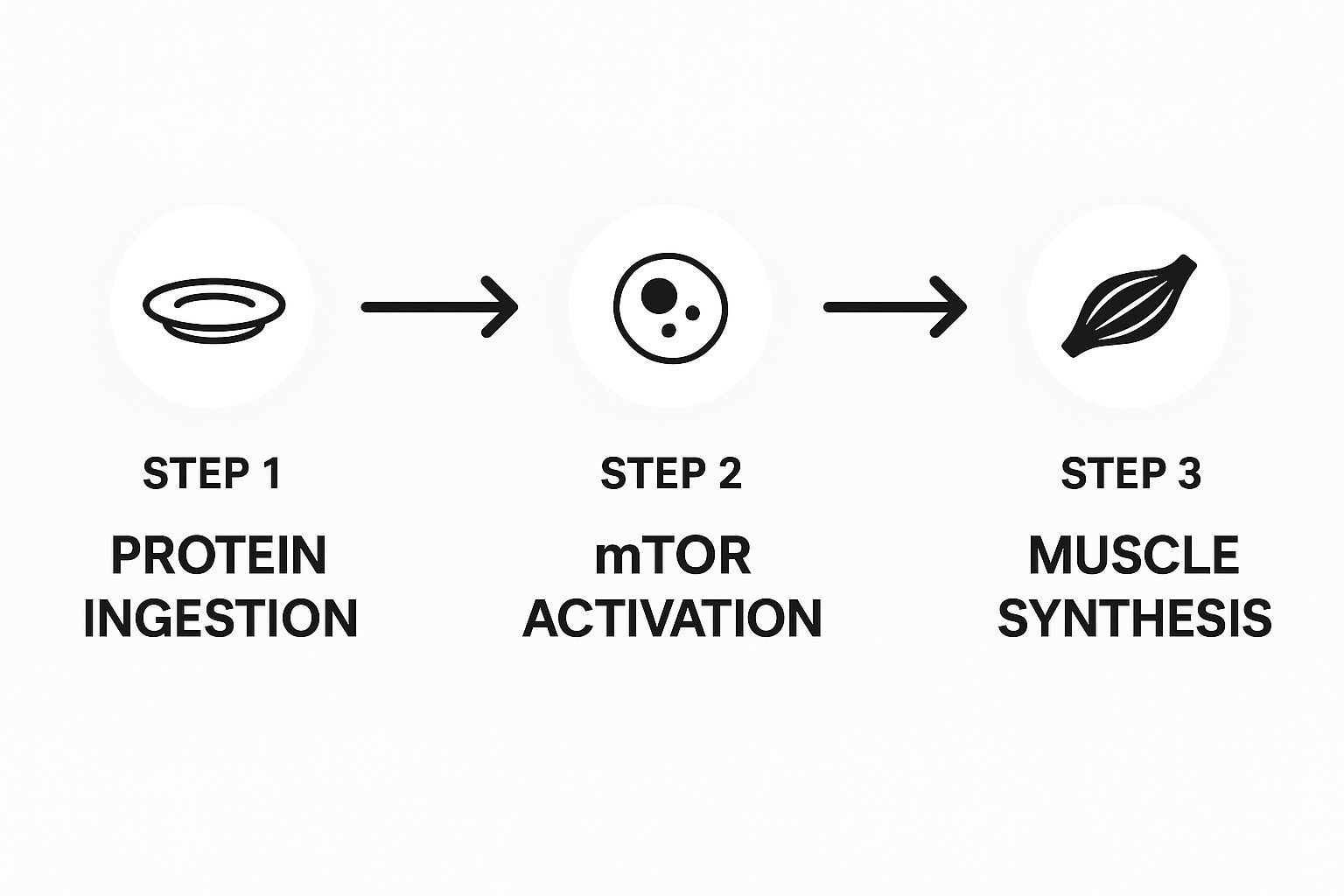
As you can see, it all starts with the fuel (protein), which enables the cellular signal (mTOR) to drive the actual construction of new muscle.
With mTOR fired up, your body is officially primed for growth. It starts pulling amino acids from your bloodstream and shuttling them over to the ribosomes. The ribosomes then get to work, reading the mRNA blueprints and linking amino acids together one by one. These new protein chains are then woven into your existing muscle fibers, making them thicker, stronger, and more resilient.
The Specifics of Building Muscle
Now, here's where it gets interesting. Not all exercise triggers muscle growth in the same way. While overall protein synthesis rates might go up after both cardio and lifting, it's the type of protein being built that really matters for getting bigger.
Resistance training specifically ramps up myofibrillar protein synthesis. This is the process that builds the actual contractile proteins—actin and myosin—that make your muscles physically larger and stronger. It’s a unique response to lifting weights.
This is precisely why hitting the weights is the most direct path to building noticeable muscle mass.
Even more fascinating, researchers have found that the direct mechanical signals from the muscle contraction are more critical for sparking this process than traditional anabolic hormones like IGF-1. This discovery really highlights the powerful, direct connection between the physical work you do in the gym and the biological response inside your muscles. To dig deeper, you can read the research on post-exercise protein synthesis. It's this beautiful interplay between the workout stimulus and the nutrients you provide that forms the true foundation of building a stronger physique.
Fueling Your Muscles for Maximum Growth
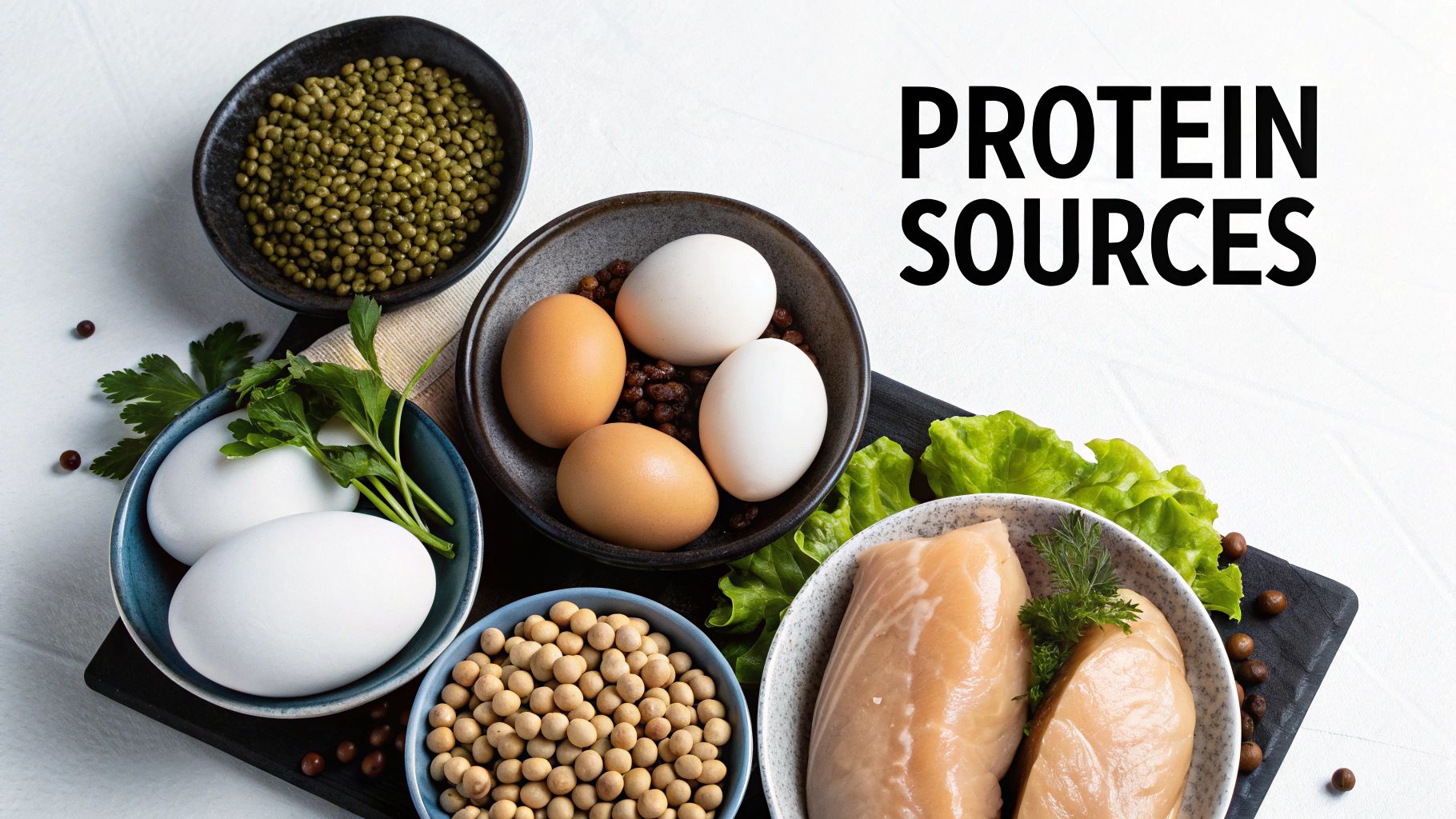
Think of your workout as the architect's blueprint for a stronger body. It sends the signal to build, but your nutrition is the truckload of bricks, mortar, and steel needed to actually do the work. Without the right raw materials, that blueprint is just a piece of paper.
Knowing what muscle protein synthesis is gets you in the game. But understanding how to feed it is how you win.
To get serious about building muscle, your nutritional game plan needs to nail three key things: how much protein you eat, what kind you’re eating, and when you eat it. Get these right, and you’ll ensure your body's construction crew is always well-supplied and ready to build.
How Much Protein Do You Really Need?
Forget the generic protein advice you see on cereal boxes. For anyone actively trying to build muscle, those numbers are way too low. When you’re training hard, your body is screaming for amino acids—the building blocks of new muscle tissue—and you need to answer the call.
So, what’s the right amount? The evidence consistently points to a daily intake between 1.6 to 2.2 grams of protein for every kilogram of your body weight. This isn't just a random number; it's the range that provides a sustained pool of amino acids to keep muscle protein synthesis humming along all day, promoting constant repair and growth.
The Power of High-Quality Protein
Here’s a secret: not all protein is created equal. The real magic lies in a protein's amino acid profile, and for triggering muscle growth, one amino acid is the undisputed MVP: leucine.
Leucine is like the foreman on a construction site who blows the horn to start the day's work. It directly activates the mTOR pathway, which is the primary signal for your body to start building muscle. To get the most out of MPS, every meal needs to hit a certain leucine threshold. This is why the quality of your protein source matters just as much as the quantity.
Aim for 20–40 grams of high-quality protein per meal. This dose reliably delivers the 2–3 grams of leucine needed to flip the "on" switch for muscle growth and get the repair process started.
Leucine Content In Common Protein Sources
Different foods pack a different leucine punch. This table gives you a quick look at how some popular protein sources stack up in their ability to stimulate MPS.
| Protein Source | Leucine per 25g Protein | Digestion Speed |
|---|---|---|
| Whey Protein | ~3.0 g | Fast |
| Chicken Breast | ~2.2 g | Moderate |
| Eggs | ~2.2 g | Moderate |
| Casein Protein | ~2.3 g | Slow |
| Soy Protein | ~2.0 g | Moderate |
As you can see, whey protein is a powerhouse because it's loaded with leucine and digests quickly, making it a fantastic choice right after a workout. Still, the best approach is a varied diet with lean meats, dairy, eggs, and well-chosen plant sources to cover all your bases. Learning the ins and outs of nutrition for strength training can further optimize your results.
Timing Your Protein for Optimal Results
Let's clear something up: the old idea of a rigid 30-minute "anabolic window" after a workout is mostly myth. Yes, getting protein in after you train is a good idea, but the real opportunity for growth lasts for 24 hours or even longer.
What matters far more than slamming a shake the second you drop the weights is how you distribute your protein throughout the entire day.
Instead of trying to eat all your protein in one or two massive meals, focus on spreading it out evenly across 3-5 meals. This strategy keeps a steady stream of amino acids flowing into your system, allowing you to repeatedly trigger muscle protein synthesis and stay in a muscle-building state from morning until night.
Training the Right Way to Kickstart Muscle Growth
Think of it this way: nutrition provides the bricks, but your workout is the foreman yelling, "Time to build!" Exercise is the powerful trigger that flips the switch on muscle protein synthesis. To send the loudest possible signal for your body to grow, your training needs to be laser-focused on one thing: creating mechanical tension.
Mechanical tension is just a fancy term for the physical stress you put on your muscle fibers when you lift weights. It's the single most important driver of hypertrophy (that's the scientific name for muscle growth). While other workouts like HIIT are great, nothing beats structured resistance training for directly telling your muscles to get bigger and stronger.
The Secret Sauce: Progressive Overload
You can't just go through the same motions forever and expect to see results. Our bodies are smart and adapt quickly. The workout that felt tough last month is probably your warm-up today. This is exactly why the principle of progressive overload is so crucial.
Progressive overload simply means you have to keep asking more of your muscles over time. It’s the absolute foundation of long-term muscle gain. By constantly providing a new, slightly harder challenge, you keep that muscle-building signal strong.
Here’s how you can do it:
- Heavier Weight: Add a little more weight to the bar.
- More Reps: Squeeze out an extra rep or two with the same weight.
- More Volume: Add another set to an exercise.
- Better Form: Improve your range of motion to create a deeper stretch and more tension.
This systematic approach is everything. To make sure your hard work is actually paying off, knowing how to track fitness progress is a non-negotiable part of the process. If you're just getting started, our complete guide on strength training for beginners will get you on the right track.
Heavy vs. Light Weights: Which Is Better?
The age-old debate: is it better to lift heavy for a few reps, or go lighter for more reps? The research is surprisingly clear on this—both work incredibly well, but only if you follow one golden rule: train close to muscular failure.
It's not just about the weight on the bar; it's about the intensity of your effort. Pushing your muscles to their limit, whether with heavy or light weight, is what sends the most powerful signal to grow.
Studies show that MPS really ramps up with intensity. Lifting a super light weight (20-40% of your one-rep max) does very little. The sweet spot for maximizing the response is in the 70-90% range. But here's the interesting part: taking a lighter weight all the way to failure can trigger a similar spike in MPS. This proves that your effort is what truly matters. A smart training program that mixes up different rep ranges is often the best way to maximize your gains.
Beyond the Gym and Kitchen: The Hidden Growth Factors
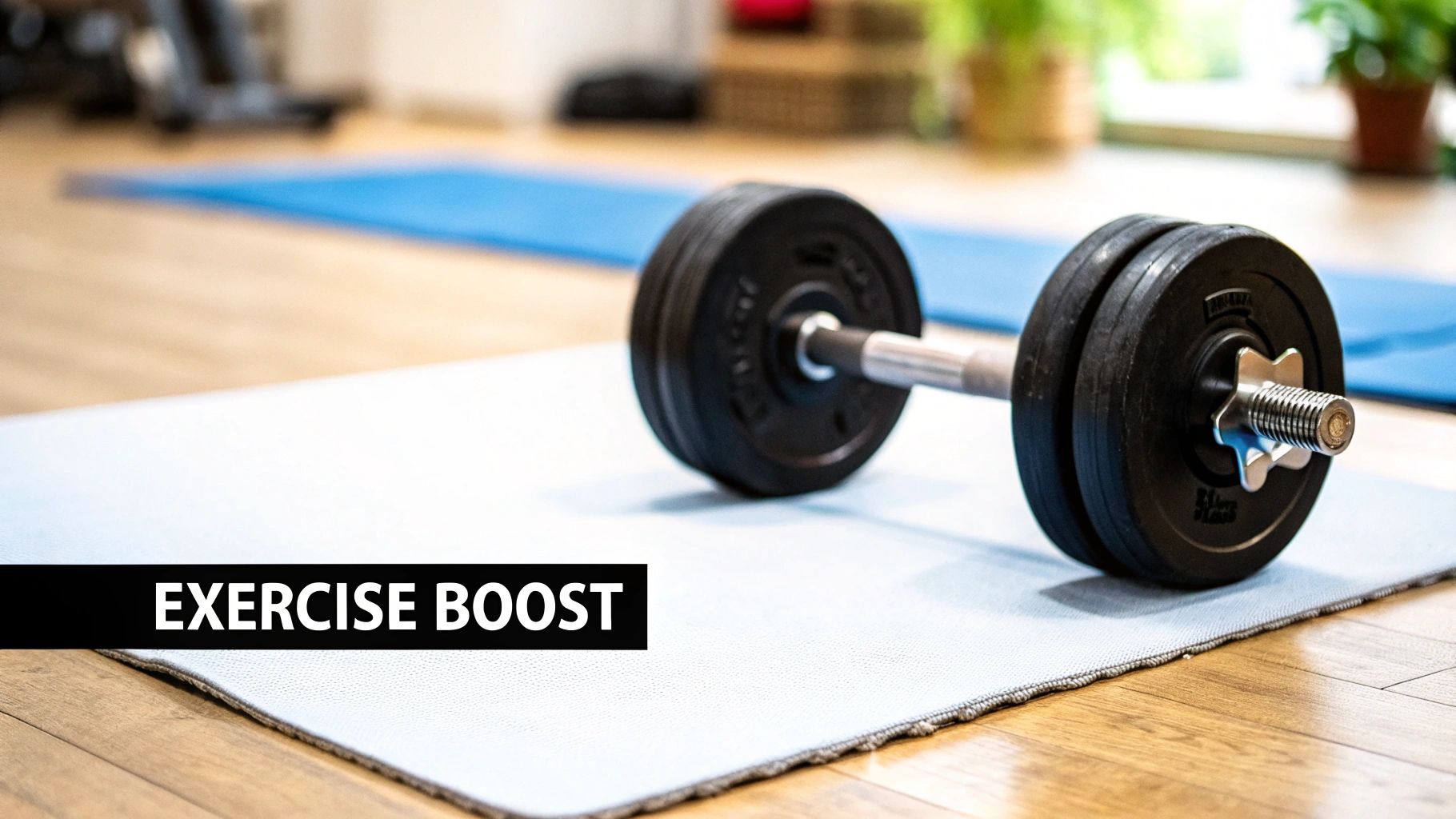
You can lift all the weights and eat all the protein you want, but the real magic of muscle growth happens when you’re not doing either of those things. The hours between your workouts are where the repair and rebuilding process truly kicks into high gear.
Ignoring these "hidden" factors is like trying to build a house without letting the concrete set. No matter how hard you train or how dialed-in your nutrition is, you'll eventually hit a wall. Progress is built on a 24/7 foundation, and that means creating an environment where your body can actually do its job.
The Anabolic Power of Sleep
Don’t think of sleep as just downtime. It’s an active, peak anabolic state for your body. This is when your system gets to work, releasing a surge of human growth hormone (HGH) to repair damaged tissues. At the same time, cortisol—the stress hormone that loves to break down muscle—drops to its lowest point.
Skimping on sleep completely flips that script. Just a few nights of poor rest can send cortisol levels soaring while HGH production tanks. This hormonal shift puts a direct brake on muscle protein synthesis, making it incredibly difficult to recover and grow.
For anyone serious about building muscle, quality sleep is non-negotiable. Aiming for a solid 7-9 hours of uninterrupted sleep each night is one of the single most powerful things you can do to support recovery and maximize MPS.
Hydration and Caloric Sufficiency
Think about this: your muscles are about 75% water. When you're even slightly dehydrated, everything slows down. Performance in the gym suffers, nutrient delivery becomes sluggish, and the cellular processes needed for repair just can't happen efficiently. Staying hydrated is fundamental.
It's also true that you can't build something from nothing. Your body needs a surplus of energy—calories—to construct new muscle tissue. If you're constantly in a steep calorie deficit, your body will shift into survival mode, prioritizing basic functions over building new muscle. You have to give it the raw materials and the energy to fuel the demanding MPS process.
These factors are the bedrock of any solid recovery plan. For a deeper dive, check out our complete guide to effective post-workout recovery.
Stress and Alcohol: The MPS Killers
Chronic stress is another major roadblock. When you’re constantly wound up, your body is marinating in cortisol. As we just covered, this catabolic hormone can directly inhibit MPS and even encourage the breakdown of existing muscle, literally undoing your hard work.
Alcohol is another progress killer. Research shows it directly suppresses muscle protein synthesis, messes with your sleep quality, and dehydrates you—a triple threat to your gains. An occasional drink probably won't derail you, but making it a regular habit will absolutely put a ceiling on your muscle-building potential.
Let's Bust Some Common Muscle Protein Synthesis Myths
The fitness world is absolutely swimming in advice, but let's be honest—a lot of it is either stuck in the past or was never right to begin with. If you really want to understand muscle protein synthesis, you first need to clear out the junk science.
So, let's cut through the noise and tackle a few stubborn myths that might be getting in the way of your gains.
The Myth of the 30-Minute "Anabolic Window"
You've probably seen this one everywhere: the frantic, post-workout dash to chug a protein shake within a tiny 30-minute “anabolic window.” The fear is that if you miss it, you've basically wasted your entire workout.
Good news: that's just not how it works.
While getting some protein in after you train is a great idea, the window of opportunity for muscle growth is much, much wider than half an hour. After a tough resistance training session, your muscles are primed for growth and remain highly sensitive to protein for at least 24 hours. So, you can relax. You have plenty of time to refuel.
Is More Protein Always Better?
Here's another one: if protein builds muscle, then more protein must build more muscle, right? Not exactly. Your body can only use so much protein for MPS at once.
Downing a massive 70-gram protein shake won't supercharge your results. Your body will simply use what it needs to kickstart the repair process, and the rest of those amino acids will be burned for energy or stored away. It's a classic case of diminishing returns.
Instead, aim for a more effective dose of 20-40 grams of high-quality protein per meal. That’s the sweet spot for maxing out the muscle-building response.
Nutrient intake does cause a spike in MPS that lasts about 1.5 hours before a "muscle-full set-point" is reached. However, resistance exercise dramatically extends this opportunity, with the combined effects of training and nutrition lasting well over 24 hours. Learn more by exploring the findings on nutrient timing and muscle growth.
Does Crippling Soreness Equal a Great Workout?
Finally, let’s talk about soreness. Many people wear their post-workout pain like a badge of honor, thinking that extreme muscle soreness is the ultimate sign of a killer session.
While a little delayed onset muscle soreness (DOMS) is perfectly normal, being so sore you can barely move for days is not the goal. In fact, severe soreness is often a sign of excessive muscle damage, which can seriously get in the way of your recovery and derail your next workout.
Remember, the objective is to stimulate your muscles, not annihilate them. A productive workout sends a strong signal for growth without causing so much damage that you can't train again for a week. Consistency is the real secret to building muscle, not crippling yourself every time you hit the gym.
A Few Common Questions About Building Muscle
Diving into the science of muscle protein synthesis is one thing, but applying it is another. Let's tackle some of the most common questions people have when trying to put all this information into practice.
How Long Does MPS Stay High After I Lift?
That powerful muscle-building signal you send with a tough workout doesn't just vanish the moment you leave the gym. Think of it less like a light switch and more like a dimmer dial that slowly fades.
After a good resistance training session, muscle protein synthesis can stay cranked up for a surprisingly long time—typically somewhere between 24 and 48 hours.
But here's a key detail: your experience level matters. If you're new to lifting, your muscles are incredibly responsive to this new challenge, and that anabolic window might stay open even longer. For seasoned lifters, the response is often faster and more efficient, returning to normal more quickly. This is why consistent, well-timed protein intake becomes even more critical the more advanced you get.
Can I Actually Build Muscle While Losing Fat?
This is the holy grail for many, isn't it? The idea of losing fat while packing on muscle—often called "body recomposition"—sounds almost too good to be true. The short answer? Yes, you can, but it's tricky and works best for certain people.
Who's most likely to pull it off?
- Beginners: Anyone new to lifting will find their body is primed to build muscle, even without a surplus of calories.
- People Returning from a Break: If you've been out of the gym for a while, your body can tap into "muscle memory," rebuilding lost tissue while you shed fat.
- Those with Higher Body Fat: Your body has plenty of stored energy (fat) it can use to fuel the demanding process of building new muscle.
The non-negotiable for making this work is a very high protein intake (think over 2.2 grams per kilogram of body weight) combined with a smart, modest calorie deficit.
Where Does Creatine Fit into All This?
Creatine is a legend in the supplement world for a reason, but its role in muscle protein synthesis isn't what most people think. It doesn't directly flip the MPS switch like protein does. Instead, its magic is a bit more indirect, but just as potent.
Creatine's main job is to supercharge your muscles' energy reserves. It helps you rapidly regenerate ATP—the fuel for explosive movements—so you can squeeze out that extra rep or add another 5 pounds to the bar.
By allowing you to train harder and create more of that all-important mechanical tension, creatine amplifies the signal for muscle growth. Simply put, creatine helps you do the work, and the work is what tells your body to build more muscle.
Ready to stop fussing with messy powders and start seeing real results? Smash.com makes staying consistent with your creatine effortless. Our delicious creatine gummies deliver the full 5g dose you need to enhance your strength, power, and recovery. No shaker, no chalky taste—just grab, go, and grow. Smash your goals today.